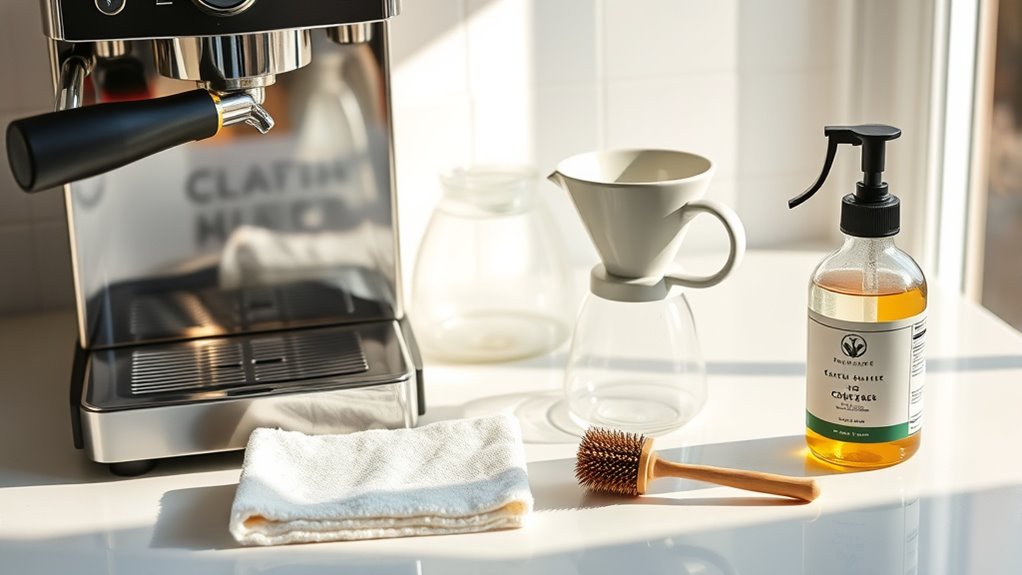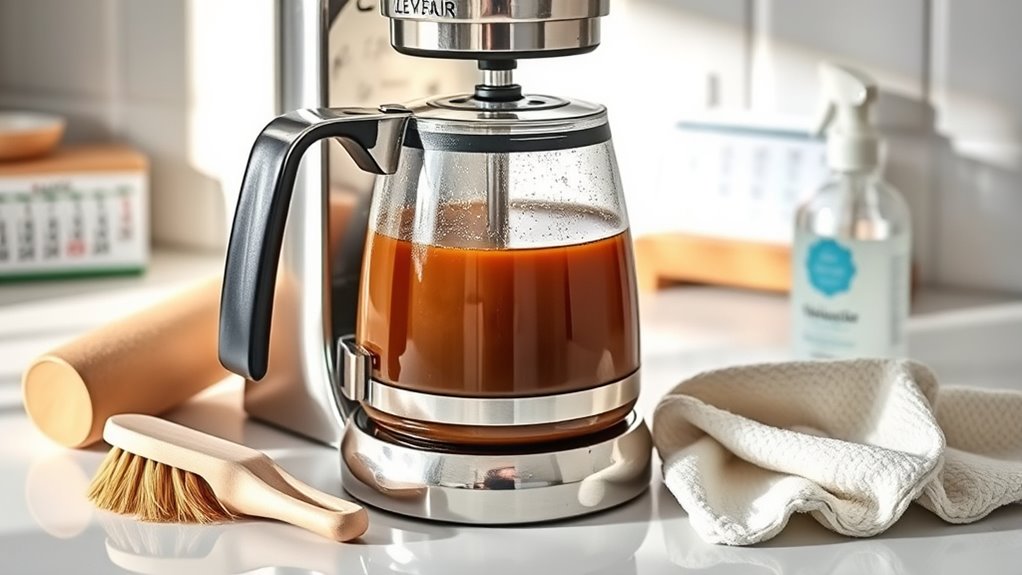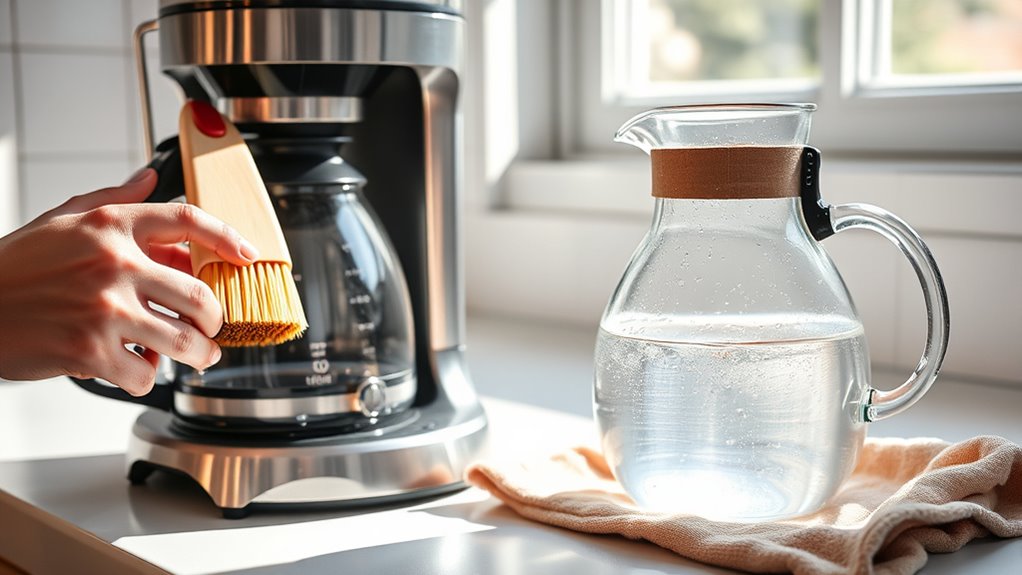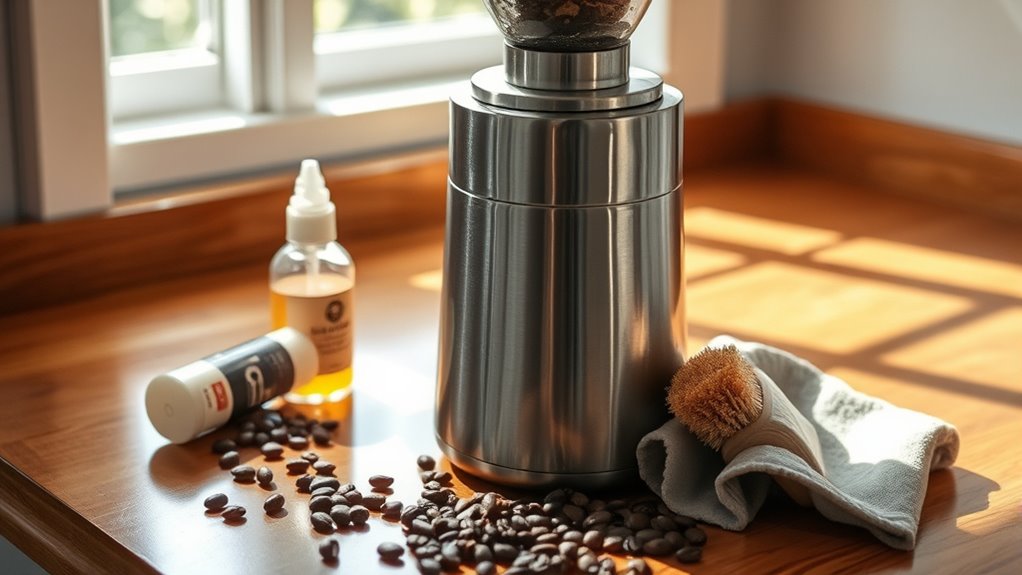To clean your coffee equipment properly, start by gathering white distilled vinegar, coffee filters, and dish soap. Look for signs like bitter coffee or mineral buildup, which mean it’s time to clean. For your coffee maker, mix equal parts vinegar and water, run a brew cycle, let it soak, and then rinse with clean water. For a Keurig, a similar vinegar solution works well. Stick around to find more tips on keeping your equipment in top shape!
Key Takeaways
- Use a 50-50 mixture of white vinegar and water to clean the coffee maker, soaking it for 30 to 60 minutes.
- Rinse the coffee maker thoroughly by brewing two cycles of clean water after the vinegar solution.
- Clean removable parts, like the brew basket and carafe, with warm soapy water regularly.
- Replace water with filtered options to minimize mineral buildup and enhance coffee flavor.
- Establish a cleaning routine every 30 days to maintain optimal performance of your coffee equipment.
What You’ll Need

Before you plunge into cleaning your coffee equipment, gather a few essential items to make the process smoother.
Start with white distilled vinegar, which effectively removes mineral buildup and is safe for your coffee maker. You’ll also need coffee filters to catch any residue while brewing the vinegar solution.
Begin your cleaning process with white distilled vinegar to eliminate mineral buildup, and remember to have coffee filters ready for residue.
If you prefer an alternative, keep baking soda on hand, mixed with warm water for odor removal. Don’t forget dish soap for scrubbing the removable parts, especially if you have a Keurig that needs regular maintenance.
Finally, verify you have clean water available for flushing the coffee maker afterward, eliminating any residual taste.
With these items, you’ll be well-prepared to tackle your coffee maker cleaning!
Signs It’s Time to Clean Your Coffee Maker

How can you tell when it’s time to clean your coffee maker? Look for oily sludge and mineral buildup on both the machine and the pot.
If your coffee tastes bitter or off, that’s another sign your coffee maker needs a good clean. Unusual noises during the brewing cycle can indicate clogs, suggesting it’s time for immediate action.
Additionally, if you notice a slower brewing process or pour, it often points to mineral buildup that requires attention. Ultimately, an unpleasant smell coming from your coffee maker is a strong indicator that cleaning is overdue.
To refresh your coffee experience, consider using vinegar in your cleaning routine to effectively tackle these issues.
How to Clean a Coffee Maker

If you notice a strange taste in your coffee or a buildup of grime, it’s time to clean your coffee maker.
You’ll want to follow a few simple steps to keep it running smoothly and guarantee great-tasting brews.
Regular maintenance won’t only enhance flavor but also extend the life of your machine.
Signs of Dirty Maker
Ever wonder when it’s time to clean your coffee maker? If you notice any of these signs, it’s definitely time for a thorough cleaning:
- Dirty Coffee: A bitter or off taste means there’s residue buildup affecting your coffee tastes.
- Visible Oily Sludge: Check for mineral buildup on the machine and pot; it’s a sure sign you need to clean.
- Unpleasant Smell: If your coffee maker emits a strange odor, it’s essential to clean it to avoid compromising the flavor of your brew.
Additionally, a slow brewing process or unusual noises during brewing indicate internal clogs.
Regular maintenance, including cleaning with vinegar, will keep your coffee maker in prime condition, ensuring you enjoy the perfect cup every time.
Cleaning Steps Explained
Cleaning your coffee maker is essential for maintaining great-tasting coffee, especially if you’ve noticed signs of buildup.
To clean a coffee maker, start by filling the reservoir with a 50-50 mixture of white vinegar and water.
Place a coffee filter in the basket, then begin a brew cycle.
Turn off the coffee maker halfway through and let the mixture soak for 30 to 60 minutes; this is where vinegar works wonders in breaking down mineral buildup.
After soaking, finish the brew cycle and dispose of the vinegar solution.
Rinse the machine by brewing with clean water twice to eliminate any residual taste.
Maintenance Tips for Longevity
To guarantee your coffee maker lasts and brews delicious coffee for years to come, establish a regular maintenance routine. Here are some key maintenance tips:
- Clean your coffee maker every 30 days using a mixture of equal parts white distilled vinegar and water. This Coffee Maker with Vinegar method helps eliminate mineral buildup.
- After running the vinegar solution, flush the machine by brewing with clean water twice to remove any residual taste.
- Regularly wash removable parts, like the brew basket and carafe, with warm soap and water to keep your coffee fresh and flavorful.
Additionally, consider using filtered water to reduce mineral concentration, ensuring you enjoy great-tasting home espresso while extending your equipment’s lifespan.
How to Clean a Keurig Coffee Maker

If you want your Keurig coffee maker to brew delicious coffee consistently, regular cleaning is essential.
Start by filling the water reservoir with a vinegar solution, mixing equal parts white distilled vinegar and water. Run a brewing cycle without a coffee pod, then turn off the machine halfway through, letting it soak for 30 minutes.
After soaking, complete the cycle and discard the solution. Run two cycles with fresh water to eliminate any vinegar taste.
Don’t forget to regularly clean the removable parts, like the drip tray and K-cup holder, using warm soapy water to prevent coffee residue buildup.
Aim to clean your Keurig coffee maker every three to six months, or more often if you notice issues.
Clean Your Coffee Grinder

Keep your coffee grinder in top shape to guarantee every brew is bursting with flavor.
Regularly clean your coffee grinder every four months to prevent any unwanted residue buildup. Here’s how to do it effectively:
Regular maintenance of your coffee grinder every four months ensures optimal flavor by preventing residue buildup.
- Disassemble: Remove and wash all plastic parts with soap and water, while keeping metal components dry to avoid rust.
- Brush & Skewer: Use brushes or skewers to clean burrs and grind chambers thoroughly, ensuring no coffee grounds are left behind.
- Grinder Cleaner: Consider using grinder cleaner tablets for a residue-free clean without disassembly.
The good news is that maintaining your grinder helps preserve the rich flavors of your coffee.
Avoid grinding hard rice or breakfast cereal, as these can dull the burrs over time.
Additional Cleaning Tips

While regular maintenance is essential for your coffee equipment, incorporating additional cleaning tips can elevate your brewing experience even further.
Hand wash your brewing basket and carafe between batches to prevent stale flavors. For effective cleaning, use a little soap and warm water, guaranteeing you safely clean away oils and residues.
Regularly clean your coffee grinder every four months to maintain its performance and flavor quality. For deep cleaning, consider using a dedicated coffee machine cleaning powder like Urnex Cleancaf, which effectively removes coffee oils and scale deposits.
Finally, always keep your equipment in a dry area and check for buildup regularly to guarantee longevity and a consistently great coffee taste. Additionally, keeping your equipment clean can help prevent off smell that may negatively affect the flavor of your coffee.
Frequently Asked Questions
What Is the Best Way to Clean Your Coffee Machine?
The best way to clean your coffee machine is by using a 50-50 mix of white distilled vinegar and water.
Run a brewing cycle with the solution, then let it soak for about 30 to 60 minutes to tackle any buildup.
After that, flush the machine by running two cycles with clean water to get rid of any vinegar taste.
Finally, hand wash removable parts and wipe the exterior with a damp cloth regularly.
Is It Better to Clean a Coffee Maker With Vinegar or Baking Soda?
Picture your coffee maker, once gleaming, now clouded with stubborn stains and mineral buildup. You’re wondering if vinegar or baking soda’s the better choice for a fresh start.
Vinegar’s your best bet; its natural acidity cuts through grime like a hot knife through butter. Mix it with water, run it through, and watch the magic happen.
Baking soda’s great for odors, but vinegar’s the true hero for tough descaling tasks.
Which Is Better, Vinegar or Descaling Solution?
When deciding between vinegar and descaling solution, it really depends on your needs.
If you’re dealing with light mineral buildup, vinegar’s a cost-effective choice. However, for heavy scaling, descaling solutions target those deposits more effectively.
Remember, vinegar may leave a slight aftertaste, so you’ll want to rinse your machine thoroughly afterward.
Ultimately, if you want long-term maintenance and protection, a descaling solution might be the better option for you.
How Many Times Should I Run Vinegar Through My Coffee Maker?
You should run vinegar through your coffee maker once for regular maintenance.
After that initial cycle, let it soak for 30 to 60 minutes to break down any mineral buildup and coffee oils.
If you notice significant buildup, consider running a second vinegar cycle for a deeper clean.
To finish, brew two cycles with fresh water to rinse out any remaining vinegar taste.
For daily users, clean your machine with vinegar monthly to maintain flavor integrity.
Conclusion
Cleaning your coffee equipment isn’t just a chore; it’s like tuning a fine instrument before a concert. When you maintain your coffee maker, grinder, and other tools, you’re ensuring every cup sings with flavor. So, don’t overlook those signs that it’s time to clean. By taking these simple steps, you’ll enjoy a fresher, richer brew each time. Remember, a little effort now means a symphony of taste in every sip later!









